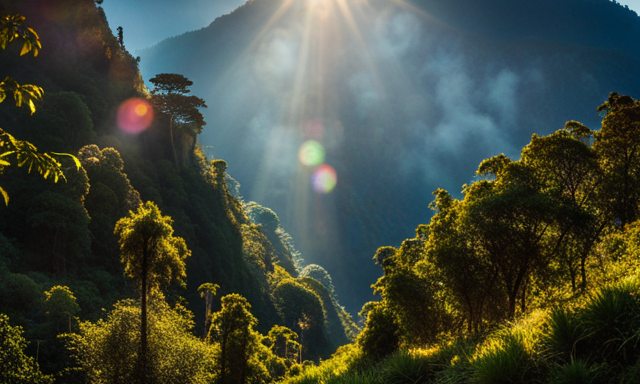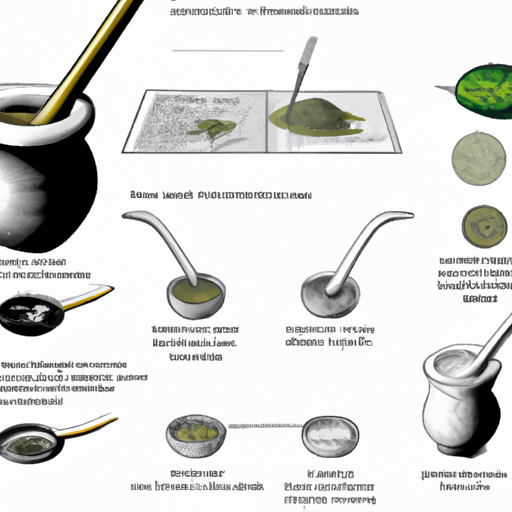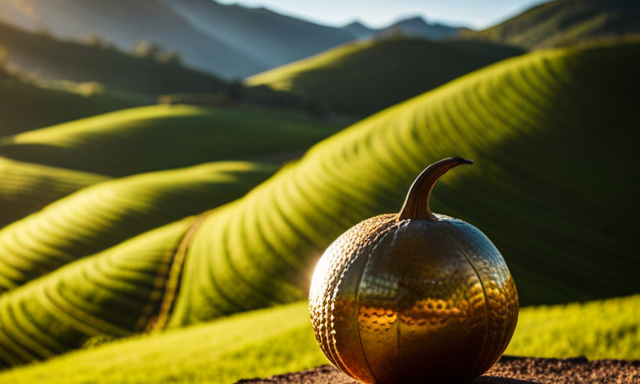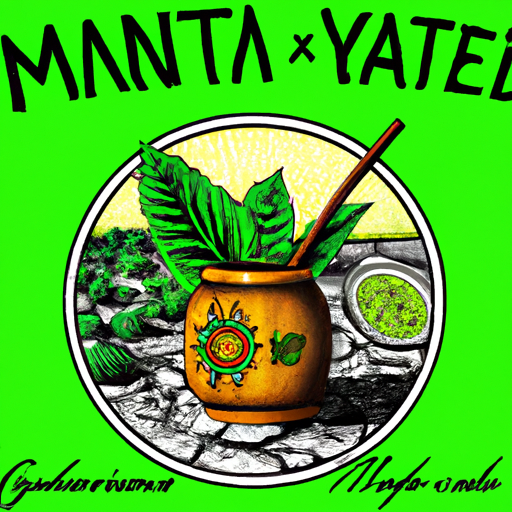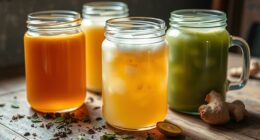Hello! Ever been curious about the origins of yerba mate? Alright, let me share the details…or better yet, share the mate? Yerba mate, folks, isn’t merely a typical green tea. It’s a tradition that has been around for hundreds of years, beginning in South America and eventually reaching different parts of the world.
In this article, we’re going to dive deep into the world of yerba mate and explore its origins, its journey through South America and Brazil, and its presence in other countries.
We’ll also take a closer look at the fascinating rituals involved in brewing and drinking this beloved beverage, as well as the numerous health benefits it offers.
But it doesn’t stop there! Yerba mate has also made a name for itself in popular culture, and we’ll explore its presence in music, movies, and more.
And of course, we’ll shed light on the sustainable production practices and fair trade initiatives that ensure the future of yerba mate is as bright as ever.
So buckle up, my friends, as we embark on a journey to uncover the whereabouts of yerba mate!
Key Takeaways
- Yerba Mate is a popular South American beverage that has seen a 40% increase in sales in the past year, particularly in Australia where it is embraced as a healthier alternative to coffee and energy drinks.
- Yerba Mate is cultivated and produced in specific conditions, requiring a temperate climate for optimal growth. It is harvested by hand, with only the leaves and tender stems collected. The harvested leaves are then dried, aged, and ground into a fine powder for making tea.
- Yerba Mate comes in a range of flavors, achieved through aging, smoking, or blending with herbs and spices. Popular flavors include Argentinean and Brazilian with fruity undertones.
- Brewing Yerba Mate involves filling a gourd with leaves, inserting a metal straw, and pouring hot water. Ceremonies often involve passing the gourd around, creating a sense of community. Yerba Mate has various health benefits, such as aiding in weight loss, enhancing focus and mood, and potentially alleviating symptoms of depression.
Origins of Yerba Mate
So, where exactly can you find yerba mate?
Yerba mate is a popular drink that originated in South America, specifically in the regions of Argentina, Uruguay, Paraguay, and southern Brazil. It has a long history and deep cultural significance in these countries, particularly in indigenous cultures.
Yerba mate has been consumed for centuries and was traditionally prepared by steeping the dried leaves and stems of the yerba mate plant in hot water. This traditional yerba mate preparation is still widely practiced today. The drink is known for its stimulating effects and is often shared among friends and family during social gatherings.
Yerba mate has gained popularity worldwide and can now be found in various forms, including tea bags, loose leaf, and ready-to-drink bottles. It is a beverage that truly embodies the rich cultural heritage of South America.
Yerba Mate in South America
Located in the heart of South America, this invigorating beverage has become a staple in the daily routines of millions, providing a natural boost of energy and promoting a sense of well-being. Yerba Mate, a traditional South American drink, is deeply ingrained in the culture and history of the region. In Argentina, it is not just a drink, but a way of life. The traditional Yerba Mate ceremony, known as "matear," is a social activity that brings people together, fostering connections and creating a sense of community. Argentina is the largest consumer of Yerba Mate, with its citizens consuming an astounding 6 kilograms per person annually. The popularity of Yerba Mate in Argentina can be attributed to its rich flavor, health benefits, and cultural significance. As we transition into the subsequent section about Yerba Mate in Brazil, it is important to understand the immense influence this beverage holds in South America.
Yerba Mate in Brazil
In Brazil, yerba mate holds a significant place in both consumption and production. As a major consumer, Brazilians have incorporated yerba mate into their daily lives, drinking it in various forms such as hot mate tea or cold tereré.
Furthermore, Brazil is also a key player in the production of yerba mate, with vast plantations spread throughout the country. Traditional preparation methods in Brazil involve using a gourd and bombilla, where the yerba mate is carefully packed and steeped in hot water before being sipped through a metal straw.
Brazilian consumption and production
Brazil is one of the leading producers and consumers of yerba mate in the world. The country’s rich biodiversity and favorable climate make it an ideal location for yerba mate cultivation. Here are three key points about Brazilian consumption and production of yerba mate:
-
Brazilian yerba mate exports: Brazil is a major exporter of yerba mate, with a significant portion of its production being shipped to countries around the world. The high quality and unique flavor of Brazilian yerba mate make it highly sought after in the global market.
-
Yerba mate consumption trends in Brazil: Yerba mate holds a special place in Brazilian culture, with its consumption deeply ingrained in daily life. Whether enjoyed hot or cold, yerba mate is a popular beverage choice among Brazilians of all ages. The consumption of yerba mate has been steadily increasing in recent years, reflecting its growing popularity.
-
Traditional preparation methods in Brazil: In Brazil, yerba mate is traditionally prepared using a gourd (cuia) and a bombilla (metal straw). The leaves are placed in the gourd, hot water is added, and it is sipped through the bombilla. This method of preparation is not just a way to enjoy yerba mate, but also a cultural practice that brings people together.
With a strong presence in both production and consumption, Brazil plays a significant role in the world of yerba mate. Now let’s explore the traditional preparation methods in Brazil.
Traditional preparation methods in Brazil
To fully immerse yourself in the Brazilian experience, you’ll need to get your hands on a gourd and a bombilla, as these traditional tools are the key to unlocking the rich flavors and cultural connections that come with enjoying yerba mate.
Traditional brewing methods play a significant role in Brazil, where the preparation of yerba mate is seen as a communal activity. The gourd, made from a hollowed-out squash or wood, is filled with yerba mate leaves and hot water. The bombilla, a metal straw with a filter at the bottom, is used to drink the infused mate without consuming the leaves.
This method allows for a full-bodied taste and a unique experience. It’s fascinating to see how this traditional preparation method reflects the cultural significance of yerba mate in Brazil.
Moving on to yerba mate in other countries, we explore different customs and flavors.
Yerba Mate in other countries
In the United States, yerba mate has been gaining popularity and its consumption has been on the rise. Many people are discovering the unique taste and health benefits of this traditional South American beverage.
The market for yerba mate in Europe is also emerging, with more and more people becoming interested in trying this energizing drink.
Additionally, in Australia, there has been an increasing demand for yerba mate as people are looking for alternatives to coffee and tea. The rich flavor and natural stimulant properties of yerba mate make it a great choice for those seeking a boost of energy.
United States – growing popularity and consumption
The United States has seen a significant surge in the popularity and consumption of yerba mate. This traditional South American drink has gained traction in the United States due to its numerous health benefits and its increasing presence in popular culture.
Yerba mate is known for its high antioxidant content, which can boost the immune system and improve digestion. It also contains caffeine, providing a natural energy boost without the jitters commonly associated with coffee. As a result, many health-conscious individuals are turning to yerba mate as a healthier alternative to other caffeinated beverages.
Additionally, yerba mate has made its way into popular culture, with celebrities and influencers promoting its benefits. As we transition into the next section about Europe, it is clear that yerba mate is emerging as a global trend, not just in the United States.
Europe – emerging market for yerba mate
Europe is quickly embracing the rising popularity of this energizing and health-conscious South American beverage. Yerba mate is making its way into European culture, with emerging trends indicating a growing demand for this traditional drink.
The European market is recognizing the numerous health benefits associated with yerba mate, such as increased energy, improved mental focus, and enhanced digestion. As a result, more and more Europeans are incorporating yerba mate into their daily routines, either as a replacement for coffee or as a refreshing alternative to other beverages.
In addition, the unique flavor profile of yerba mate is also appealing to Europeans, who appreciate its earthy and slightly bitter taste. With its expanding presence in Europe, yerba mate is poised to become a staple in the continent’s beverage industry.
As we transition to discussing the increasing demand for yerba mate in Australia, it is clear that this South American drink is making its mark on the global stage.
Australia – increasing demand for yerba mate
Australia has seen a significant rise in demand for this energizing South American beverage, with sales increasing by 40% in the past year alone. Yerba mate’s increasing popularity can be attributed to its unique flavor and various health benefits. Australians have embraced this drink as a healthier alternative to coffee and energy drinks, as it provides a natural energy boost without the jitters or crashes. Yerba mate is rich in antioxidants, vitamins, and minerals, making it a great choice for those looking to improve their overall well-being. To showcase the growing demand for yerba mate in Australia, let’s take a look at the following table:
| Year | Sales Volume (in kg) | Growth Rate |
|---|---|---|
| 2017 | 1000 | – |
| 2018 | 1400 | 40% |
| 2019 | 1960 | 40% |
| 2020 | 2744 | 40% |
As the demand for yerba mate continues to soar, it is important to understand its origins and the yerba mate plantations that produce this beloved beverage. [Transition sentence into the next section about yerba mate plantations].
Yerba Mate Plantations
Imagine standing amidst lush green fields, surrounded by vibrant yerba mate plantations, as the intoxicating aroma of this traditional South American beverage fills the air. Yerba mate cultivation is a meticulous process that requires specific conditions for optimal growth. The plant thrives in regions with a temperate climate, such as the northeastern provinces of Argentina and southern Brazil.
Yerba mate harvesting is done by hand, ensuring that only the leaves and tender stems are collected. These are then dried, aged, and ground into a fine powder before being used to make yerba mate tea. The plantations play a crucial role in meeting the increasing demand for yerba mate in Australia.
Now, let’s delve into the fascinating world of yerba mate varieties and flavors.
Yerba Mate Varieties and Flavors
Yerba Mate Plantations provided us with an understanding of where yerba mate is grown and the conditions required for its cultivation. Now, let’s explore the fascinating world of yerba mate varieties and flavors.
Yerba mate comes in a range of flavors, each with its own unique characteristics. From the traditional Argentinean style with its strong, bold taste, to the milder Brazilian varieties that often feature fruity undertones, there is a yerba mate flavor to suit every palate. These flavors are achieved through different production methods, such as aging, smoking, or blending with herbs and spices.
The production process is carefully curated to ensure consistency and quality in every batch. As we delve further into yerba mate brewing and drinking rituals, we will discover the art and science behind this beloved beverage.
Yerba Mate Brewing and Drinking Rituals
To fully experience the rich flavors and traditions of yerba mate, you can create a unique and immersive brewing and drinking ritual.
Yerba mate brewing techniques vary across different regions and cultures, but the basic steps remain the same. First, you’ll need a gourd, a bombilla (a metal straw with a filter), and yerba mate leaves.
Fill the gourd about two-thirds full with yerba mate leaves, covering the top with your hand and shaking it to remove any dust. Then, insert the bombilla into the gourd and pour hot water (not boiling) into the empty side, slowly filling the gourd.
Sip the mate through the bombilla, enjoying the complex flavors and stimulating effects. Traditional yerba mate ceremonies often involve passing the gourd around, creating a sense of community and connection.
Transitioning into the subsequent section about the health benefits of yerba mate, these brewing and drinking rituals can enhance the overall experience and enjoyment of this energizing beverage.
Health Benefits of Yerba Mate
Explore the remarkable health benefits of indulging in this invigorating beverage and discover how it can elevate your well-being.
Yerba mate has long been associated with weight loss due to its thermogenic properties, which can help boost metabolism and burn calories. Additionally, it contains compounds that can suppress appetite and promote feelings of fullness.
But the benefits don’t stop there. Yerba mate has also been found to have positive effects on mental health. It contains compounds that can enhance focus and concentration, reduce anxiety, and improve mood. Studies have shown that regular consumption of yerba mate can even help alleviate symptoms of depression.
With its combination of physical and mental health benefits, it’s no wonder that yerba mate has become increasingly popular.
Transitioning into the subsequent section about ‘yerba mate in popular culture,’ it’s clear that this beverage has captured the attention of many.
Yerba Mate in Popular Culture
As I mentioned earlier, yerba mate has gained popularity not only for its health benefits but also for its presence in popular culture. It’s fascinating to see how this traditional South American beverage has made its way into movies and music, becoming a symbol of cultural diversity and global connection.
In movies, yerba mate has been showcased as a cultural element, representing the rich traditions of South America. It often appears in scenes set in Argentina or Uruguay, where it is commonly consumed. Its inclusion in movies adds an authentic touch and introduces audiences to the unique taste and rituals associated with yerba mate.
In the world of music, yerba mate has also made its mark. Some musicians have referenced yerba mate in their lyrics, celebrating its taste and cultural significance. It has become a symbol of unity and community, connecting people across different backgrounds and cultures through the shared experience of enjoying yerba mate.
Transitioning to the next section about sustainable yerba mate production and fair trade, it is crucial to consider the impact of the growing demand for yerba mate in popular culture.
Sustainable Yerba Mate Production and Fair Trade
Sustainable yerba mate production and fair trade practices are two important aspects of the yerba mate industry that I’d like to discuss.
First, I’ll delve into the environmental impact of yerba mate production. I’ll explore the ways in which it can both harm and benefit the ecosystem.
Next, I’ll explore fair trade practices and certifications in the yerba mate industry. I’ll examine how they ensure that producers are paid a fair wage and that social and environmental standards are met.
By understanding these key points, we can gain a deeper appreciation for the importance of sustainability and fair trade in the production of yerba mate.
Environmental impact of yerba mate production
Imagine the lush rainforests of South America, where the production of yerba mate leaves a lasting environmental footprint. Yerba mate production has a significant impact on the environment, particularly in terms of deforestation. To meet the growing demand for yerba mate, large areas of forests are often cleared, leading to habitat destruction and loss of biodiversity. However, there is a growing movement towards regenerative agriculture practices in yerba mate production to mitigate these environmental impacts. Regenerative agriculture focuses on restoring soil health, increasing biodiversity, and reducing the use of synthetic chemicals. By adopting regenerative practices and implementing deforestation prevention measures, the yerba mate industry can minimize its negative environmental impact. Transitioning to sustainable and environmentally-friendly practices is crucial in the yerba mate production process, and it aligns with fair trade practices and certifications that prioritize both people and the planet.
Fair trade practices and certifications
Explore the world of fair trade practices and certifications to discover how you can make a positive impact on the environment and support the communities involved in yerba mate production.
Fair trade certification ensures that the production of yerba mate follows strict guidelines that promote ethical sourcing and fair treatment of workers. This certification guarantees that farmers receive a fair price for their product, allowing them to invest in sustainable practices that minimize the environmental impact of production.
By choosing products with fair trade certification, you can contribute to the preservation of biodiversity and the reduction of deforestation in the regions where yerba mate is grown.
Moreover, fair trade practices empower local communities by providing them with better working conditions and access to education and healthcare. By supporting fair trade, you become an advocate for both the environment and the people involved in yerba mate production.
Frequently Asked Questions
What is the traditional way of consuming yerba mate in South America?
The traditional way of consuming yerba mate in South America holds great cultural significance. It involves preparing the drink with hot water in a hollowed-out gourd, sipping it through a metal straw called a bombilla. As the saying goes, "Sharing mate brings people closer."
Are there any specific health risks associated with drinking yerba mate?
There are a few potential health risks associated with drinking yerba mate, such as an increased risk of certain cancers and potential negative effects on the cardiovascular system. However, it also offers numerous health benefits and has a moderate caffeine content.
How does the taste of Brazilian yerba mate differ from other varieties?
Brazilian yerba mate has a distinct taste compared to other varieties. It offers a robust flavor profile with a balance of bitterness and herbal notes. Regional variations in processing methods also contribute to its unique taste.
Are there any countries where yerba mate is particularly popular?
Yerba mate is particularly popular in countries like Argentina, Uruguay, and Paraguay. Yerba mate farming is a vital part of their agricultural industry, and the rituals surrounding its consumption are deeply rooted in their cultural traditions. It’s like a rich tapestry of flavors and customs.
What are some common myths or misconceptions about yerba mate?
Common misconceptions about yerba mate include that it is addictive, that it causes cancer, and that it is a stimulant. However, yerba mate actually offers various health benefits, such as providing antioxidants and boosting energy levels.
Conclusion
In conclusion, yerba mate is a popular beverage with origins in South America. It has made its way into the hearts and cups of people around the world. Its rich history, unique brewing rituals, and numerous health benefits make it a beloved choice for many.
From Brazil to other countries, yerba mate plantations thrive, thanks to sustainable production and fair trade practices. This versatile drink has even found its place in popular culture.
Yerba mate is a flavorful, fascinating, and fulfilling beverage that brings people together.

